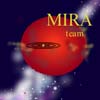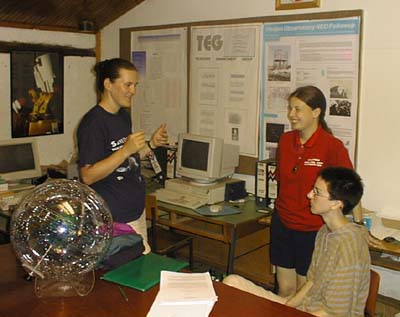VISNJAN, August, 2000

|
Marina Rejkuba |
team leader |
Mario Juric |
team leader |
Tvrtko Bedekovic |
member |
Kristina Klemencic |
member |
Senka Pintaric |
member |
Group programe:
Old images were taken from the archive, and new images with the same co-ordinates were shot

Work on the images
http://cdsweb.u-strasbg.fr/Sim bad.html)
The group managed to process 10 fields. We
lost a lot of time because we had to install IRAF and learn how to use it, find all the needed images in the archive and code the programs needed to analyse the data. But the biggest problem was the difference in quality of the
archived and new images. It was very difficult to look for the variables just by blinking them because of differences in seeing and telescope tracking. To overcome this problems we performed aperture photometry with IRAF and
compared directly the magnitudes of the stars. While we were blinking one pair of images taken during the school and checking their quality, we found a very faint object whose position changed in a short time span of about 10 minutes. We observed
the same field in the consecutive three nights and confirmed the presence of the new asteroid. In colaboration with the NEO group we sent the coordinates and the magnitudes to the Minor Planet Center (MPC). On the 1. 8. 2000.
MPC sent us the designation for that asteroid: K00O07F. From the magnitude (around 18 mag) and its position we estimated that it belongs to the main asteroid belt and its size is around 7 km. In the next few weeks it should become
brighter.
In the 10 fields we found only 3 candidates for variable stars with changes in brightness more than 1 mag. Two of them are also point sources in the 2MASS catalog but are not brighter than the other stars of the field. In table 1 we list coordinates, variation of magnitude and the names of the images where these 3 variables were found. In the column "2MASS" the detection in the infrared images is flagged as well as its presence in the SIMBAD database.

HOME PROGRAM LECTURES PROJECTS EXCURSION TRICK AND TIPS APPLICATION FORM VARIOUS